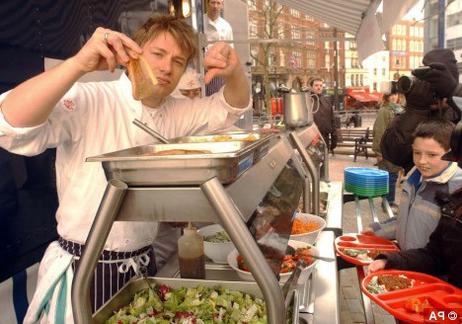Obesity has become an epidemic in the United States, and the incidences of diseases related directly to weight continue to rise. To help combat this problem, English chef Jamie Oliver has created his own form of "reality television," heading into the lunchrooms of public schools across the country in an attempt to transform the way Americans look at and eat foods from a young age. Oliver's program, "Food Revolution," spent its first season inside schools in West Virginia, transforming school lunches and breakfasts into healthier fare. During the second season, Oliver planned to bring his healthy food program to schools in Los Angeles – but sometimes, things don't go quite the way we plan.
The Conflict
Jamie Oliver had planned to head into the school cafeterias in Los Angeles in a similar fashion to the way he moved into West Virginia schools – getting a full assessment of the current condition of lunches and breakfasts served through the school system. However, Los Angeles schools were not as willing to comply with Oliver's requests, and his cameras were denied access completely to any Los Angeles school cafeterias. Administrators for the schools said on a blog that previous negative experience with reality TV shows left them unwilling to bring any more drama to the Los Angeles school stage.
"This is not a boutique cafe operation," outgoing Los Angeles Unified School District Superintendent Ramon Cortines told Oliver in February. "I do not believe the school district should be a stage…and in the last several weeks you and your company have attempted to make the school district a stage."
Robert Alaniz, director of communication for LAUSD, told the Wall Street Journal, "Jamie fancies himself as a crusading journalist. But we just didn't want reality television filming in our schools. We welcome him – sans cameras – to work with our menu committee to see if we can improve it. That invitation is still open."
Getting In
One Los Angeles school did decide to let Oliver in on the cafeteria action. Megan Cherin, chairman of MLA Partner schools agreed to let Oliver work within one of the MLA schools, West Adams Prep. Cherin told Oliver he could have access to both students and faculty, as long as his work remained within the school curriculum and Oliver stayed out of the school cafeteria since the food served there is regulated by the district. Oliver was able to spend time with staff and students at the school, discussing the obesity problem in the country and how to make healthier food choices, before the district got involved and banned Oliver from MLA schools as well.
While at West Adams, Oliver was able to make a positive impact on some of the students that attend the school. Caleb Villanueva, a high school senior at West Adams, cooked with Oliver while he was at the school. Villanueva told WSJ that Oliver taught them that eating healthy doesn't have to cost a lot of money.
"Jamie taught us that not only rich people can eat healthily," Villanueva said. "In reality, anybody can eat healthy with just some thought – you don't have to fry chicken in oil; you can put it in the oven and roast it with some herbs. When Jamie cooked for us, he really proved his point – you don't need to spend a lot of time and money on food in order to make it healthy. You just need to be creative."
Success in West Virginia
Oliver has already proven that he has the ability to turn around school cafeterias, after his experience in West Virginia. During his first season, Oliver went into Cabell County Schools in this state to remake the way their school cafeterias fed students across the county. Despite complaints from some in the district that Oliver made fun of West Virginians and Americans, many parents and students at the schools appreciated Oliver's efforts and many of the positive changes to school menus are still in existence today.
Mary Neely, vice president of the Cabell County School Board, told , "It was a positive show. It did not show Huntington in a negative way. He did a wonderful job. I think a lot of people in Huntington changed their eating habits." Neely added, "Jamie made a really positive impact on the eating habits of people in Huntington and the rest of the United States. Anybody that watched it, learned from it."
On a Mission
Despite the setbacks he faced in Los Angeles this year, Oliver is still focused on his mission to bring healthier eating to the school system throughout the United States. In an interview with Yum Sugar, Oliver said his vision is much bigger than simply changing the menus at school cafeterias.
Oliver stated, "I think every supermarket in the country, period, should sponsor a school - $20,000, $30,000 a year. That could represent a salad bar, a garden, a few key members of staff, a few hours here and there. Can they afford to do it? Of course. Is it propagating the customers of the future? Of course. It's ethically a win-win."
With the success of his television program and an Emmy Award under his belt, it looks like Oliver's healthy food crusade is here to stay – at least for a little while. For those who have learned to cook and eat healthier thanks to Oliver's instruction, his stay in our country should not be too short-lived. Alas, for the school districts challenged to revamp their current cafeterias and menus, Oliver appears to have already worn out his welcome. However, as of the date of this publication, it does actually appear that Jamie Oliver has another shot at revamping LAUSD. John Deasy, who is the new superintendent, is reconsidering the decision made by his predecessor, as reported by the .
Questions? Contact us on Twitter. @publicschoolreview













